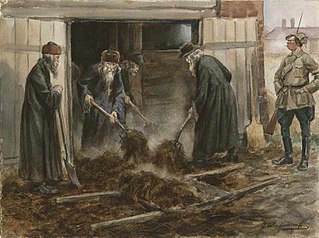
Debt bondage, also known as debt slavery, bonded labour, or peonage, is the pledge of a person's services as security for the repayment for a debt or other obligation. Where the terms of the repayment are not clearly or reasonably stated, or where the debt is excessively large the person who holds the debt has thus some control over the laborer, whose freedom depends on the undefined or excessive debt repayment. The services required to repay the debt may be undefined, and the services' duration may be undefined, thus allowing the person supposedly owed the debt to demand services indefinitely. Debt bondage can be passed on from generation to generation.

Redemptioners were European immigrants, generally in the 18th or early 19th century, who gained passage to the American Colonies by selling themselves into indentured servitude, to pay back the shipping company which had advanced the cost of their transatlantic voyage. British indentured servants generally did not arrive as redemptioners, after the early colonial period, due to certain protections afforded them by law. Redemptioners were at a disadvantage because they negotiated their indentures upon their arrival in America, after a long and difficult voyage, with no prospect to return to their homelands.

Indentured servitude is a form of labor in which a person is contracted to work without salary for a specific number of years. The contract, called an "indenture", may be entered voluntarily for purported eventual compensation or debt repayment, or it may be imposed involuntarily as a judicial punishment. Historically, it has been used to pay for apprenticeships, typically when an apprentice agreed to work for free for a master tradesman to learn a trade. Later it was also used as a way for a person to pay the cost of transportation to colonies in the Americas.

Coolie is a pejorative term used for low-wage labourers, typically those of Indian or Chinese descent.

Forced labour, or unfree labour, is any work relation, especially in modern or early modern history, in which people are employed against their will with the threat of destitution, detention, violence including death or other forms of extreme hardship to either themselves or members of their families.

Chinese Peruvians, also known as tusán, are Peruvian citizens whose ancestors came from China.
On February 19, 1862, the 37th United States Congress passed An Act to Prohibit the "Coolie Trade" by American Citizens in American Vessels. The act, which would be called the Anti-Coolie Act of 1862 in short, was passed by the California State Legislature in an attempt to appease rising anger among white laborers about salary competition created by the influx of Chinese immigrants at the height of the California Gold Rush. The act sought to protect white laborers by imposing a monthly tax on Chinese immigrants seeking to do business in the state of California.

The Immigration Depot is a building complex located in Port Louis on the Indian Ocean island of Mauritius, the first British colony to receive indentured, or contracted, labour workforce from many countries. From 1849 to 1923, half a million Indian indentured labourers passed through the Immigration Depot, to be transported to plantations throughout the British Empire. The large-scale migration of the labourers left an indelible mark on the societies of many former British colonies, with Indians constituting a substantial proportion of their national populations. In Mauritius alone, 68 percent of the current total population is of Indian ancestry. The Immigration Depot has thus become an important reference point in the history and cultural identity of Mauritius.
The Indian indenture system was a system of indentured servitude, by which more than 1.6 million workers from British India were transported to labour in European colonies, as a substitute for slave labor, following the abolition of the trade in the early 19th century. The system expanded after the abolition of slavery in the British Empire in 1833, in the French colonies in 1848, and in the Dutch Empire in 1863. British Indian indentureship lasted till the 1920s. This resulted in the development of a large South Asian diaspora in the Caribbean, Natal, East Africa, Réunion, Mauritius, Sri Lanka, Malaysia, Myanmar, and Fiji, as well as the growth of Indo-Caribbean, Indo-African, Indo-Mauritian, Indo-Fijian, Indo-Malaysian, and Indo-Singaporean populations.
Chinese Caribbeans are people of Han Chinese ethnic origin living in the Caribbean. There are small but significant populations of Chinese and their descendants in all countries of the Greater Antilles. They are all part of the large Chinese diaspora known as Overseas Chinese.

Indentured servitude in Pennsylvania (1682-1820s): The institution of indentured servitude has a significant place in the history of labor in Pennsylvania. From the founding of the colony (1681/2) to the early post-revolution period (1820s), indentured servants contributed considerably to the development of agriculture and various industries in Pennsylvania. Moreover, Pennsylvania itself has a notable place in the broader history of indentured servitude in North America. As Cheesman Herrick stated, "This system of labor was more important to Pennsylvania than it was to any other colony or state; it continued longer in Pennsylvania than elsewhere."

The padrone system was a contract labor system utilized by many immigrant groups to find employment in the United States, most notably Italian, but also Greeks, Chinese, Japanese, and Mexican Americans. The word 'padrone' is an Italian word meaning 'boss', 'manager' or 'owner' when translated into English. The system was a complex network of business relationships formed to meet a growing need for skilled and unskilled workers. Padrones were labor brokers, usually immigrants or first-generation Americans themselves, who acted as middlemen between immigrant workers and employers.
Human trafficking in Mauritania is considered to be a controversial human rights issue. Mauritania is a suspected source and destination country for men, women, and children subjected to trafficking in persons, specifically conditions of forced labor and commercial sexual exploitation. Supposedly, some women, men, and children from traditional slave castes are subjected to slavery-related practices, rooted in ancestral master-slave relationships, which continue to exist in a limited fashion in both rural and urban settings. These individuals, held for generations by slave-holding families, may be forced to work without pay as cattle herders and household help. Mauritanian and West African boys – referred to as talibes – are recruited to study at Koranic schools, but are sometimes subsequently subjected to forced begging within the country by religious teachers known as marabouts. Girls have been trafficked internally and from neighboring West African countries such as Mali, Senegal, and Gambia for involuntary domestic servitude. Mauritanian girls have been married off to wealthy men from the Middle East and taken there in some cases for forced prostitution. Mauritanian women are forced into prostitution within the country, as well as in the Arab States of the Persian Gulf.
Irish transport to Barbados dates back to the 1620s, when Irish people began arriving on the island. The majority were emigrants, indentures, and merchants, though with an unknown number of political and convict transportees during the 1650s
Indentured servitude in continental North America began in the Colony of Virginia in 1609. Initially created as means of funding voyages for European workers to the New World, the institution dwindled over time as the labor force was replaced with enslaved Africans. Servitude became a central institution in the economy and society of many parts of colonial British America. Abbot Emerson Smith, a leading historian of indentured servitude during the colonial period, estimated that between one-half and two-thirds of all white immigrants to the British colonies between the Puritan migration of the 1630s and the American Revolution came under indenture. For the colony of Virginia, specifically, more than two-thirds of all white immigrants arrived as indentured servants or transported convict bond servants.
Irish Caribbeans are people who live in the Caribbean, but were born in Ireland, or are descended from people who were born in Ireland. Irish Caribbeans include:

Indentured servitude in British America was the prominent system of labor in the British American colonies until it was eventually supplanted by slavery. During its time, the system was so prominent that more than half of all immigrants to British colonies south of New England were white servants, and that nearly half of total white immigration to the Thirteen Colonies came under indenture. By the beginning of the American Revolutionary War in 1775, only 2 to 3 percent of the colonial labor force was composed of indentured servants.

Labor trafficking in the United States is a form of human trafficking where victims are made to perform a task through force, fraud or coercion as it occurs in the United States. Labor trafficking is typically distinguished from sex trafficking, where the task is sexual in nature. People may be victims of both labor and sex trafficking.

The history of forced labor in the United States encompasses to all forms of unfree labor which have occurred within the present day borders of the United States through the modern era. "Unfree labor" is a generic or collective term for those work relations, in which people are employed against their will by the threat of destitution, detention, violence, lawful compulsion, or other extreme hardship to themselves or to members of their families.
Migration from India into Africa pre-dates European colonization. The number of Indians in Africa increased greatly with the settlement of Indians in Africa as indentured servants during colonization, and has continued to increase into the 21st century.